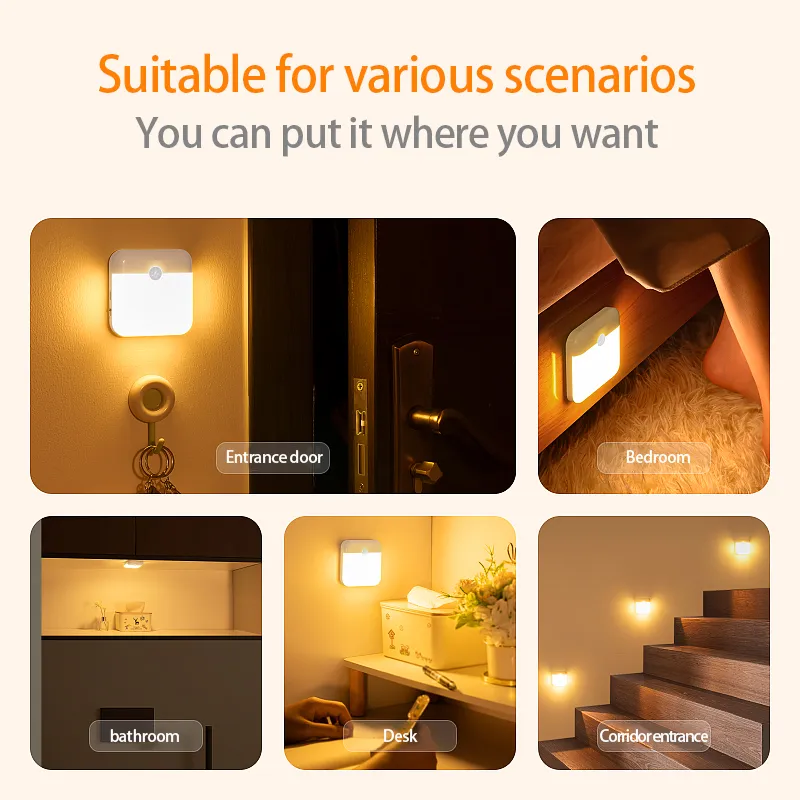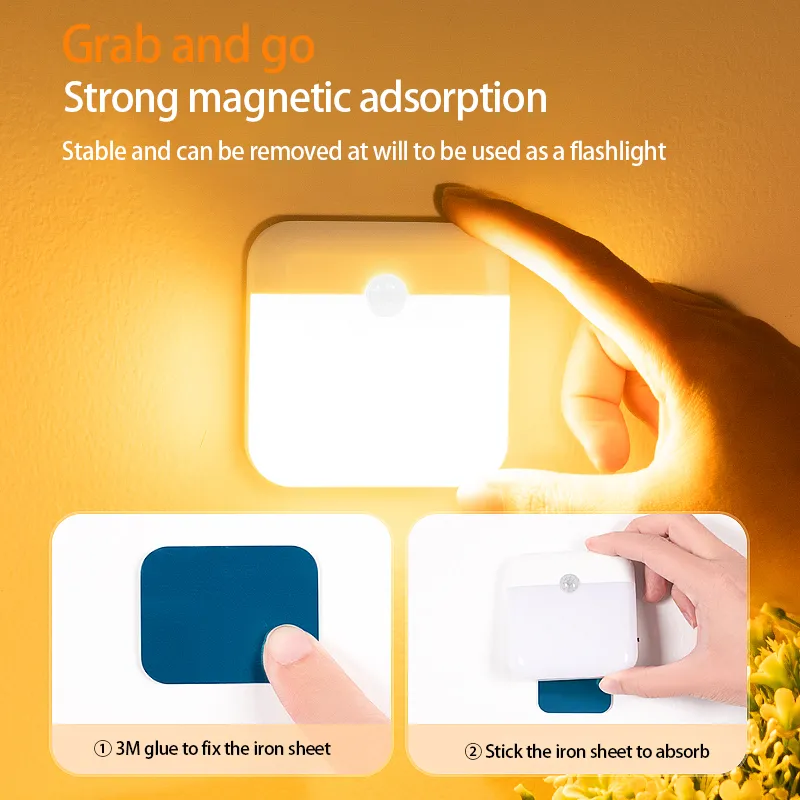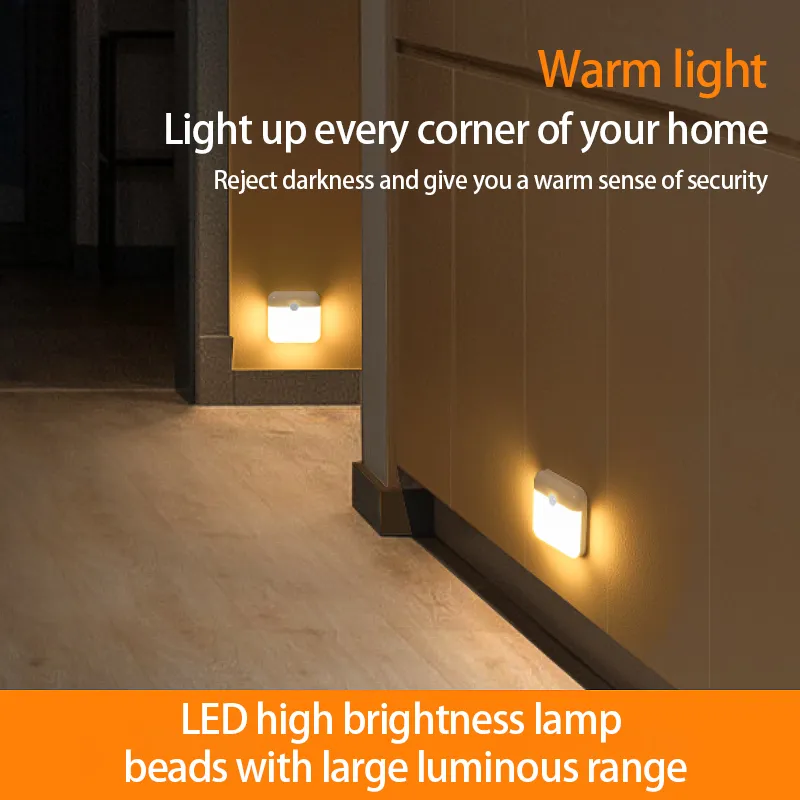What are the Pros and Cons of motion sensor night light?
Motion sensor night light has become a common lighting device in modern homes, offices and commercial environments. With the popularity of smart home devices, motion sensor night light, as a solution for automatic sensing lighting, has gradually been accepted by more and more users for its convenience, energy saving and safety. Despite this, as a lighting product with automatic control function, motion night light still has some advantages and disadvantages, which deserve consumers' careful consideration when purchasing.
This article will comprehensively analyze the advantages and disadvantages of motion sensor night light to help consumers better understand the actual effect and applicable scenarios of this device.

What is the principle of motion sensor night light?
Before discussing the advantages and disadvantages in detail, you first need to understand the working principle of motion sensor night light. Motion night light detects changes in the surrounding environment, especially the movement of human body or objects, through built-in motion sensors. Common motion sensors are infrared sensors (PIR, active infrared sensors) and microwave sensors. Infrared sensors usually sense temperature differences (such as human body heat), while microwave sensors detect the movement of objects by emitting microwave signals.
When these sensors detect motion, the lights will automatically turn on, and when no motion is detected, the lights will automatically turn off. This design can effectively save energy and provide users with a convenient lighting experience. The functions of motion sensor night light are mainly reflected in automatic switching, energy saving, and convenient operation.

What are the advantages of motion sensor night light?
The advantages of motion sensor night light are mainly reflected in its automatic control, energy saving effect, safety and convenience. Specifically, the following advantages are factors that consumers often consider when choosing motion sensor night light:
1. Energy saving and environmental protection
One of the biggest advantages of motion sensor night light is its energy saving effect. Traditional lighting fixtures often require manual switching, which not only increases energy consumption, but also easily generates unnecessary lighting waste. Motion sensor night light, through intelligent control, will only turn on when it senses the movement of human body or object, thus avoiding the situation of wasting energy in unmanned rooms for a long time. This motion-based intelligent switching method enables users to use electricity more efficiently.
In addition, many motion sensor night lights use LED light sources, and LED bulbs themselves have low power consumption and long service life. Therefore, the motion night light can not only avoid energy waste, but also further reduce electricity bills, which is in line with the trend of environmental protection and energy saving.
2. Improved safety
Another significant advantage of the motion sensor night light is that it improves the safety of home and commercial environments. At night or in a dark environment, especially when the lights are not on, it is often inconvenient to use traditional switches to control lamps. The motion sensor night light automatically senses the movement of people or objects and automatically lights up in the dark, effectively avoiding safety hazards such as falls and collisions caused by groping for switches at night.
For example, in areas such as bedrooms or corridors, when the elderly or children get up at night, the motion night light will automatically turn on to provide sufficient lighting to avoid accidents such as falls. This function is especially suitable for people with limited mobility or poor eyesight, further improving the safety of the home environment.
3. Convenient operation
The convenience of the motion night light is another major advantage. Traditional lamps require manual operation of the switch, especially in the dark or on the bed, sofa, etc., turning the light on and off may require users to walk or grope. The design of motion sensor night light allows users to turn on the light automatically without any additional operation. It only needs to move naturally or enter the sensing range, which greatly facilitates the lighting needs of users when it is inconvenient or impossible to operate the switch.
For example, in scenes such as bedrooms or bathrooms, motion sensor night light can automatically light up when users enter and exit without any additional operation. For users who enter and exit the same room many times, the automated switching method can reduce unnecessary switching operations and improve the convenience of life.
4. Extend the life of lamps
The motion sensor night light's automatic control system allows lamps to be turned on only when needed, thus avoiding excessive wear caused by turning on the lamps for a long time. Compared with traditional lamps, motion sensor night light can automatically turn off when not in use, reducing the working time of the bulb and thus extending the life of the bulb.
For LED lamps, due to their longer service life and lower power consumption, motion sensor night light can better play the advantages of LED lamps, reduce the frequency of bulb replacement, and reduce maintenance costs.

What are the disadvantages of motion sensor night light?
Although motion sensor night light has many significant advantages, it is not perfect. Some of its shortcomings may affect the user experience, especially in certain specific environments and scenarios. The following are the main shortcomings of motion night light:
1. Susceptible to interference from environmental factors
The working principle of motion sensor night light is based on sensing changes in the surrounding environment, especially infrared sensors and microwave sensors. However, the sensor may be interfered by environmental factors, resulting in false triggering or failure to trigger.
For example, in an environment that is too cold or too hot, the temperature difference of infrared sensors may be difficult to sense, resulting in the failure of the lamp to turn on normally; while microwave sensors may be falsely triggered due to too many reflective objects (such as walls, large furniture, etc.). In addition, pets, small objects or air flow may also affect the sensitivity of the sensor, resulting in frequent switching of lights or failure to sense human movement.
2. Installation and adjustment issues
The installation and adjustment of motion sensor night light are relatively complicated. During installation, it is necessary to determine the best installation position of the sensor to ensure that the sensor can cover the expected monitoring area. If the sensor is installed in the wrong position, it may cause the lamp to fail to respond normally. For example, the sensor may not sense movement in a specific area, or react too sensitively, causing the light to flicker frequently.
In addition, although some motion sensor night lights support sensitivity adjustment, the adjustment process may require certain technical experience. For ordinary consumers, failure to properly install and adjust the sensor may result in its function not being able to perform at its best.
3. Turning on or off the light by mistake
Because motion night lights are highly dependent on the sensitivity of the sensor, they are prone to turning on or off the light by mistake. For example, when certain objects (such as fallen objects, animals, or air flow) move within the monitoring range of the sensor, the light may be triggered by mistake. In areas where no one is active for a long time, the sensor may not detect movement in time, resulting in the failure of the light to turn on.
This misoperation phenomenon will cause a certain impact on the stability and reliability of the lighting. In particular, when the user enters the room at night, the failure of the lamp to respond or frequent switching may affect the user's experience.
4. High initial cost
Although motion sensor night lights can bring energy saving and convenience in long-term use, their initial purchase cost is usually higher than that of traditional lighting equipment. This is because motion night lights use more complex technologies (such as infrared sensors, microwave sensors, etc.) and intelligent control systems, so their prices are higher.
For consumers with limited budgets, the initial investment of a motion sensor night light may be a consideration. In addition, if multiple motion sensor night lights are required to cover a large space, the overall investment may also be relatively large.

Huari Lighting Co., Ltd is a leading Chinese manufacturer of LED lighting products, delivering high-quality solutions for over two decades. With a production capacity exceeding 1 million units each month, we supply a full range of LED lighting products including downlights, ceiling lights, and bulbs. All of our products are certified with CE, RoHS, and ERP standards, ensuring premium quality. As a reliable supplier, we offer competitive pricing, bulk purchasing discounts, and the option for customized orders.
